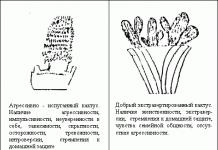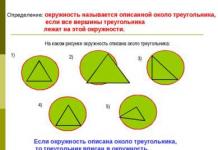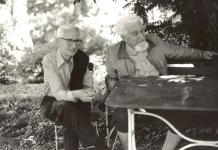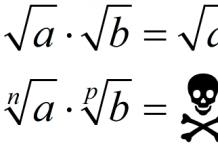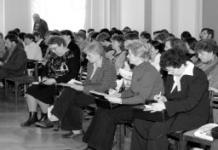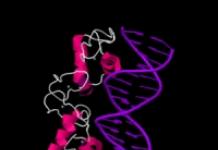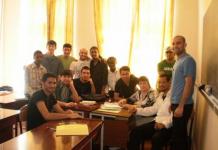Method (from ancient Greek μέθοδος - the path of research or knowledge, from μετά- + ὁδός “path”) is a systematized set of steps, actions that must be taken to solve a certain problem or achieve a certain goal.
Any major stage in the development of linguistics involves a change in views on language and a change in the research method, the desire to create your own method.
Methods are divided into general and specific, general scientific and methods of specific science.
General methods: generalized sets of theoretical attitudes, techniques, and methods of language research. They represent the unity of “method - theory”. Each general method emphasizes that aspect of language that seems more important, for example, the comparative historical method.
Private Methods: a set of techniques, operations that are based on certain theoretical principles, technical means, and research tools.
General scientific methods: for example, analysis, synthesis, observation, experiment.
General linguistic methods:
1. Comparative historical linguistics: general method - comparative-historical; private methods – the method of language reconstruction.
2. Structuralism: general methods – structural; private methods - distributive analysis, the method of direct components, the method of oppositions (Prague Linguistic Circle).
3. Generative linguistics, cognitive linguistics, computational linguistics, etc.: general methods – constructive (modeling method), aimed at creating conceptual models of language functioning that not only describe, but also explain observed facts and predict the conditions for their occurrence. Particular methods: transformation method, component analysis.
4. Main types of models (according to A.N. Baranov):
5. 1. Component models or structure models (what X is made of).
6. 2. Predictive models (predict the behavior of X in certain circumstances).
7. 3. Simulating models (outwardly behave like X).
8. 4. Diachronic models (how and why X changes over time).
Basic private methods in modern linguistics:
1. Component analysis method: a method of studying the content side of significant units of language, with the goal of decomposing meaning into minimal semantic components. K. a. m was first used in research lexical material as a technique for describing a narrow circle lexical units(kinship terms) in different languages (50s of the 20th century).
2. Transformation method: a method of representing the syntactic structure of a sentence, based on the derivation of complex syntactic structures from simpler ones using a small set of transformation rules (transformations).
3. Method of direct components: a method of representing the derivational structure of a word and the syntactic structure of a phrase or sentence in the form of a hierarchy of nested elements.
4. Distributive analysis: a method of language research based on the study of the environment (distribution, distribution) of individual units in the text. In modern linguistics it is used in semantic research to identify the combinatory characteristics of linguistic units.
5. Contextual analysis method– the meaning of a linguistic unit is determined using a necessary and sufficient fragment of text.
6. Quantitative methods : the use of calculations and measurements in the study of language and speech. For example, determining the frequency of linguistic units, identifying correlations of the frequency of semantic properties, etc.
7. Experimental methods: linguistic and psycholinguistic experiments. A linguistic experiment (the concept was introduced by L.V. Shcherba, further developed by O.N. Seliverstova) is a test of the correctness/acceptability of a linguistic expression constructed by a researcher on the basis of a theoretical model. Psycholinguistic experiment - appeal to the linguistic intuition of native speakers, while the subjectivity of the results is compensated big amount subjects.
Modern tendencies in the development of methods are characterized by a rejection of the exclusivity of one or another general method, the desire to combine and combine various general scientific, general and particular linguistic methods.
METHODOLOGY OF LINGUISTICS, in a narrow sense, is a set of standard techniques and means (methods and techniques) of research formed in the process of development of linguistic science, based on plausible assumptions about the nature of the object being studied and ensuring the achievement of the goal. In a broad sense, to any methodology scientific discipline include not only the techniques and means of research, but also what are called metascientific beliefs and values shared by the community of people involved in a given science.
Methods of linguistic analysis:
1. Method linguistic observation and description, or descriptive method – the main method of language research, which consists in identifying specific linguistic phenomena and their consistent description in terms of their structure and/or functioning. For example, a description of all forms plural nouns in a given language during a certain period of its historical development.
2. Method component analysis involves analyzing the meanings of linguistic units through identifying the main components of meaning, or seven. In the verb "to come", for example, in general meaning we can distinguish such components or semes as “action” (or “activity”), “movement”, “independence” (or “activity” on the part of the performer), “direction”, “repetition”, etc. When studying lexical meanings it is often used analysis of dictionary definitions , that is, interpretations of the meanings of words that are given in various types of dictionaries. These interpretations contain all the necessary information about the component composition of the meaning of this word and the possibilities of its use.
3. It is also important for linguistic research conceptual analysis , or analysis of linguistic concepts and their interpretation in the dictionary.
4.Contextual analysis used to study the functional specifics of words and their meanings, it represents an analysis of the text (a fragment of text, a sentence) in which a given word is used, as well as an analysis of the dependence of the meaning of the word on this context.
5. One more important method is valence and compatibility analysis words used in the study of syntactic properties of linguistic units. Valence analysis examines the valence of a word, that is, its potential ability (embedded in its very meaning) to be used with certain classes of words in a specific syntactic function, for example: the ability of a verb to be combined with certain types of subjects, objects (predicative syntagma) and circumstances. Compatibility analysis involves studying syntactic connections of a given word in a sentence, for example, the compatibility of a verb and a noun (agreement on several grammatical categories depending on the typological status of this language). Sometimes the potential compatibility of a word, based on its meaning, is called the semantic valence of the word, and its actual syntactic connections are called syntactic valence. The first and second may often not coincide.
6. To determine the functionality of language units, identify hidden syntactic connections and meanings, it is used transformation method (transformations; transformations). It consists in changing the structure of a linguistic unit (usually a phrase or sentence), its syntactic model. For example, the transformation of a construction in the active voice into a construction in the passive.
7.Diagnostic models are used to determine the meaning of a linguistic unit that does not have an explicit formal expression (so-called hidden meanings). This is done to present a given meaning in a more obvious, explicit form. For example, to determine the meaning of the activity of an action on the part of the performer, or agency, in modern linguistics models with the verb are used do (He broke the door – What he did was break door; But: The door broke – What the door did break), while verb models are used to identify the meaning of a process or state change happen (What happened to the door was that it broke).
8. In order to identify the meanings of linguistic units and their functionality, it is widely used experimental method , which consists in the artificial creation of a certain linguistic situation, for example, using one or more specially invented sentences in order to test their possibility and impossibility and, accordingly, the correctness or incorrectness of the use of certain linguistic units.
9. The main theoretical and experimental methods for studying linguistic units in the language system and in speech also include linguistic modeling method , which involves the compilation of models, that is, diagrams or samples, of linguistic units (word-formation model, sentence model, etc.) or the language as a whole (structural and functional models of language).
10. Widely used in linguistics statistical methods – methods of calculation with the help of which the frequency of certain phonemes in a word is established, the frequency of use of a particular linguistic unit in a certain text or in a language as a whole, the typicality of specific linguistic phenomena for a certain period of language development or for a certain linguistic style. For this purpose, they are often used various ways indexing, which determines the number of uses of the analyzed form (or word) for every 100 words of text.
11.Continuous sampling method a selection of examples is carried out for analysis and illustration of theoretical positions: extracting from the original (non-adapted) text in a row all the examples of the analyzed type found in it.
Many people still think that linguists are, at best, those who compose school books in the Russian language and for some reason they force us to say “ringing And sh", and at worst - just someone like polyglots or translators.
In fact, this is not true at all. Modern linguistics is expanding the boundaries of its interests more and more, merging with other sciences and penetrating almost all spheres of our life - if only because the object of its study is everywhere.
But what exactly are these strange linguists studying?
1. Cognitive linguistics
Cognitive linguistics is a field located at the intersection of linguistics and psychology and studies the connection between language and human consciousness. Cognitive linguists are trying to understand how we use language and speech to create certain concepts, concepts, categories in our heads, what role language plays in the process of our cognition of the world around us and how our life experience reflected in the language.
The problem of the influence of language on cognitive processes has been in science for a very long time (many are familiar with the Sapir-Whorf hypothesis of linguistic relativity, which assumes that the structure of language determines thinking). However, cognitive scientists also continue to wrestle with the question of to what extent language influences consciousness, to what extent consciousness influences language, and how these degrees relate to each other.
Quite interesting and new is the use of the achievements of cognitive linguistics in the field of analysis literary texts(so-called cognitive poetics).
Researcher at the Institute of Linguistics of the Russian Academy of Sciences Andrey Kibrik talks about cognitive linguistics.
2. Corpus linguistics

Obviously, corpus linguistics is concerned with the compilation and study of corpora. But what is a hull?
This is the name given to a collection of texts in a particular language, which are marked in a special way and which can be searched. Corpora are created in order to provide linguists with a sufficiently large amount of linguistic material, which will also be real (not some artificially constructed examples like “mother washed the frame”) and convenient for searching for the necessary linguistic phenomena.
This is enough new science, which originated in the USA in the 60s (at the time of the creation of the famous Brown Corps), and in Russia in the 80s. It's coming now productive work over the development of the National Corpus of the Russian Language (NCRL), which includes many subsections. For example, such as the syntactic corpus (SinTagRus), corpus poetic texts, spoken language corpus, multimedia corpus and so on.
Doctor of Philological Sciences Vladimir Plungyan about corpus linguistics.
3. Computational linguistics

Computer linguistics (also: mathematical or computational linguistics) is a branch of science formed at the intersection of linguistics and computer technology and in practice, including almost everything related to the use of programs and computer technology in linguistics. Computational linguistics deals with the automatic analysis of natural language. This is done in order to simulate the work of language in certain conditions, situations and areas.
This science also includes work on improving machine translation, voice input and information retrieval, and the development of programs and applications that rely on the use and analysis of language.
In short, “okay, Google”, and searching for VKontakte news, and the T9 dictionary are all achievements of excellent computer linguistics. At the moment, the area is the most developing in the field of linguistics, and if suddenly you also like it, you are welcome at the Yandex School of Data Analysis or at ABBYY.
Linguist Leonid Iomdin on the beginnings of computer linguistics.

That is, what we say is considered as a communication event, in conjunction with gestures, facial expressions, speech rhythm, emotional assessment, experience and worldview of the participants in communication.
Discourse analysis is an interdisciplinary field of knowledge in which, along with linguists, sociologists, psychologists, artificial intelligence specialists, ethnographers, literary scholars, stylists and philosophers participate. All this is very cool, because it helps us understand how our speech works in certain situations. life situations, what mental processes occur at these moments, and how all this is connected with psychological and sociocultural factors.
Sociolinguistics now actively continues to grow and develop. You may have heard about the sensational problems - the extinction of dialects (spoiler: yes, they are dying out; yes, this is bad; allocate funds to linguists, and we will fix everything, and then languages will not drown in the abyss of oblivion) and feminists (spoiler: no one has understood yet , good or bad).
Doctor of Philology M.A. Krongauz about language on the Internet.
Method often means the general methodology of the sciences, a philosophical method of cognition that formulates the basic principles of the theory of knowledge as a whole. For us, such a general scientific, philosophical method is the dialectical method, according to which matter is primary and consciousness is secondary; matter and consciousness form a unity; movement is a way, a form of existence of matter, therefore the material world must be studied, cognized in movement; the phenomena of the world around us are interconnected, etc. These and other principles of the dialectical method form the philosophical basis of any science oriented towards materialist dialectics, including linguistics. On the other hand, by method is meant the method of obtaining a specific scientific knowledge. Consequently, the linguistic method is the means, the way by which we obtain information about language and learn about language. The combination of such methods constitutes a system of special methods. The most general definition method: “...a set of techniques and operations of cognition and practical transformation of reality.” To obtain effective results using special methods of language learning, you must use these methods correctly and be proficient in them. The rules, the sequence of using linguistic methods, as well as their constituent techniques are the methodology of linguistic analysis.
The methods and techniques of linguistic analysis are closely related to the aspect and concept of scientific research.
2. General scientific, general and specific linguistic methods
In scientific studies there are general methods (analysis and synthesis, comparison, etc.), general scientific methods(observation, measurement, experiment, etc.) and particular methods (for example, the comparative historical method in linguistics). We will call a specific version of a particular method aimed at solving a certain class of research problems a “methodology”.
Lecture 2. Scientific paradigms of linguistic knowledge
In the development of any science, including linguistics, there is a gradual change in scientific paradigms. The term “paradigm of scientific knowledge” was introduced by T. Kuhn in his work “The Structure of Scientific Revolutions.” The paradigm is"recognized by all scientific achievements, which over a period of time provide the scientific community with a model for posing problems and their solutions.” In the history of linguistics stands out three scientific paradigms - comparative historical, systemic structural and anthropocentric.
1.
Comparative historical paradigm associated with the dominance of comparative historical method in language research. Science dealt with the origin of languages, the reconstruction of the proto-language, the establishment of relationships between related languages and the description of their evolution, and the creation of comparative historical grammars and dictionaries.
2.
System-structural paradigm characterized by knowledge of the structure of language and its organization. The defining thesis was F. de Saussure’s thesis, according to which the object of linguistics should be language “in itself and for itself.” The paradigm continues to exist, within its framework research is carried out that makes a significant contribution to the development of linguistics.
3. Anthropocentric paradigm arises as a result of the realization that “language, being a human institution, cannot be understood and explained without connection with its creator and user” (Kravchenko 1996: 6). The origins of the paradigm go back to the ideas of W. von Humboldt and E. Benveniste. It was W. von Humboldt who noted that “a person becomes a person only through language, in which the creative primary powers of a person, his deepest capabilities, operate. Language is the united spiritual energy of the people” (Humboldt 1984: 314).
Lecture 3. Basic linguistic principles
In linguistics, the following linguistic principles are identified that determine the development of modern linguistics, such as: explanatoryism, expansionism, functionalism, which were formulated and justified, and then received further interpretation in the works of a number of researchers (Vorkachev, Kravchenko Popov, etc.).
1. Explanation- the desire not only to describe the facts of language, but also to find an explanation for them.
2. Explanation was also present in previous linguistic paradigms, but only in the new paradigm does it come to the fore, pushing aside the formal description, i.e. in the “description-explanation” dyad there is a shift in emphasis.
P. M. Frumkina gives an aphoristic description of the predicted future of linguistics, expressed at one time, who predicted the transition from “what-linguistics” (description of structures) to “how-linguistics” (description of processes), and then to the creation of “why-linguistics”. This “emphasizes the value of explanation (although it is seen as a task for the future), and not just description,” which corresponded to the state of affairs in linguistics of previous periods. It is “the pathos of cognitive linguistics that lies in the focus on explanation.” The description is aimed “at comprehending the structure and semantics of linguistic objects,” the explanation is “at elucidating their functioning.” As he noted, in order to explain the features of the object of study, including language, “one must go beyond its boundaries. And this is a law for all explanatory sciences without exception. In any science, the transition from the descriptive stage to the explanatory stage is inevitably associated with the involvement of data from certain related sciences into its orbit.” Consequently, explanatoryism is inextricably linked with expansionism.
3.
Expansionism. Linguistic expansion consists in the emergence of new objects of research, in the revision of traditional problems from new positions. The strengthening of expansionist attitudes is manifested in the desire to expand the field of linguistic research, the emergence of outlets in
other sciences and the active use of information from other sciences - cultural studies, sociology, anthropology, ethnology, psychology, neuroscience, etc.
In linguistic research, “the focus of research attention naturally shifts from the studied center to the problematic periphery and is fixed at the junction of areas of scientific knowledge: ethnopsychology, psycholinguistics, cognitive psychology, sociolinguistics, cognitive linguistics, ethnolinguistics arise, within which the process of interdisciplinary synthesis and symbiosis continues...”
4. Functionalism. The main requirement of functionalism is to study language in action, as it performs its functions. The new scientific paradigm is characterized by a reorientation of scientific interests from the primary study of the internal laws of the language system to consideration of the functioning of language as the most important means communication. In the process of linguistic research, all laws and mechanisms of the functioning of language in its interaction with a person cognizing the world must be studied in detail and fully disclosed.
Thus, linguistic expansionism is closely related to “explanatoryism as the desire to find a reasonable explanation for every linguistic phenomenon and anthropocentrism and functionalism as tendencies to seek similar explanations in the role of the human factor in language and the performance of certain functions by language.”
5. To the considered principles of modern linguistics, according to a number of scientists, two more can be added - textocentrism and semanticocentrism.
Semanticocentrism. The question of the dominant side of language - the plane of expression and the plane of content - was resolved differently at different stages of the development of linguistics. During the period of dominance of the system-centric approach, semantics did not achieve significant success and “only an appeal to anthropocentrism on a new, higher basis made it possible to advance in its study.” Semanticocentric ideas - ideas about the dominance of the content side of language - are reflected in the works of E. Sapir, A. Vezhbitskaya, representatives of the Moscow semantic school. , analyzing the features of the development of semantic theories at the end of the 20th century, points to the expansion of the object of semantics, noting that it “is... any linguistic meanings, i.e., the meanings of lexemes, grammes, derivatives, syntactic structures, etc.
Text-centrism. The features of anthropocentric linguistics are most clearly manifested in text studies, since “all linguistic realities acquire true meaning only in the text. Without an indication of how a particular linguistic unit or category is involved in the creation of a certain type of text, the idea of language will be incomplete.” It is impossible to study a text without the person who is its creator and addressee. The text reflects the image of the world, captures the dynamics of thought and ways of representing it using linguistic means.
Thus, the main principles of the new linguistic paradigm are anthropocentrism, expansionism, functionalism, explanatoryism, semantic centrism and textocentrism. Within the framework of the named paradigm and in accordance with its principles, several scientific directions
, the most significant of which are cognitive linguistics and cultural linguisticsLecture 4.
In Russian linguistics, he spoke about anthropocentrism as the basic principle of modern linguistics, analyzing the concept of E. Benveniste: “Language is created according to human standards, and this scale is imprinted in the very organization of language; in accordance with it, the language should be studied. Therefore, in its main trunk, linguistics will always be the science of language in man and man in language.”
The emergence of the anthropocentric paradigm in linguistics was predetermined, since language itself is anthropocentric in its essence, “man imprinted in language his physical appearance, his internal states, his emotions, his intellect, his attitude to the objective and non-objective world, nature, his relationship to the collective of people and to another person." The researcher’s gaze moves from the object of knowledge to the subject, the person in the language and the language in the person are analyzed.
The essence of anthropocentrism as the main principle of linguistic research is that “scientific objects are studied primarily according to their role for a person, according to their purpose in his life, according to their functions for the development of the human personality and its improvement. ... A person becomes the starting point in the analysis of certain phenomena; he is involved in this analysis, determining its prospects and ultimate goals.”
Lecture 5. Comparative-historical method
1. Conditions that prepared the comparative historical method
The comparative historical method was prepared and matured over a long period of time, spanning centuries. This is natural, because it represented and represents not only and not so much a well-known formal scientific, purely technical procedure, although this is important, but rather a reflection of a certain level of culture and the level of awareness of this culture. First of all, this is a fairly strict and at the same time flexible concept, based on an extensive factual base. It couldn't happen suddenly revolutionary way. Appropriate conditions were needed, which included:
1. Expansion of linguistic horizons, which began with the Renaissance and put an end to medieval narrowness. It was expressed, in particular: a) in the growth of interest in the Greek language (along with Latin - the main language of the Middle Ages), oriental languages, mainly Semitic (Hebrew, Arabic, Syriac); b) in introducing the circle of philological (linguistic) interests of living European languages(compilation of empirical grammars of these languages, dictionaries, including multilingual ones, etc.); this had the result of revealing not only the extraordinary diversity of languages, but also the need to compare them in search of similar features; The first attempts are being made to classify languages.
2. Dissatisfaction with philosophical, rational, largely speculative, general theories, divorced from the real picture of the diversity of languages; overcoming dogmatic ideas about language as an eternal and immovable phenomenon.
3. Awareness of the connection of language with forms of culture, with the national worldview, character and customs, which leads to the inclusion of language in a broad cultural context with moving boundaries determined ethnically, historically, geographically, etc.
4. The general spread of the principle of historicism, which began with natural sciences and then covering the social sciences. The realization comes that all social institutions - law, customs, religion, economics, social classes and languages are constantly changing, the explanation of the various states of these institutions in one period or another with the help of abstract principles no longer satisfied scientists; descriptions of the development of these social institutions from some previous state began to be preferred to similar explanations - taking into account objective external conditions that caused this or that change.
5. Discovery of Sanskrit as genetically related to European ones. In 1786, the English orientalist and lawyer William Jones, in a report read at the Asiatic Society in Calcutta, came to the conclusion that Sanskrit exhibits such similarities with the ancient Greek and Latin languages both in the roots of verbs and in their grammatical forms that cannot be explained by coincidence. This similarity is so striking that every philologist, confronted with it, must inevitably come to the conclusion that these languages have a common source that may no longer exist. Although Jones did not propose a developed methodology that led him to such a conclusion, the very fact of ascertaining the genetic relationship between languages separated by enormous distances, distributed on different continents, was of outstanding importance: he directed research thought to the need for more detailed comparative work involving both those indicated by him , and other languages, the search for a common source, perhaps no longer existing. Consequently, the comparison would have to be made taking into account the time factor, i.e. historically.
Thus, by the end of the 18th century. the course of development of philological thought led to the fact that the study of languages was carried out, on the one hand, in a comparative sense (to identify similarities between them) and, on the other, in a historical sense (to resolve the issue of language change in connection with changes in social institutions , in the popular worldview - these were the methodological aspirations of romantic philologists, as well as in search of an answer to the question of what is the common source of related languages). The time, the state and demands of philology itself posed a grandiose task, the solution of which depended on whether a scientific method worthy of this task would be found. And it was proposed - this is a comparative historical method, with the discovery and implementation of which linguistics turns into a genuine science.
2. The concept of comparative historical method- a scientific method, with the help of which, through comparison, the general and special in historical phenomena are revealed, knowledge of the various historical stages of development of the same phenomenon or two different coexisting phenomena is achieved; a type of historical method. Comparative-historical method allows you to identify and compare levels in the development of the object being studied, the changes that have occurred, and determine development trends.
Can be isolated various shapes comparative-historical method A: comparative method, which reveals the nature of heterogeneous objects; historical-typological comparison, which explains the similarity of phenomena unrelated in origin by the same conditions of genesis and development; historical-genetic comparison, in which the similarity of phenomena is explained as a result of their relatedness in origin; a comparison in which the mutual influences of various phenomena are recorded.
The comparative historical method is a set of techniques that allows one to prove the kinship of certain languages and restore ancient facts their stories. The method was created in the 19th century, its founders were the wonderful scientists Rasmus Raeck (Denmark), Franz Bopp (Germany), Jacob Grimm (Germany) and Alexander Vostokov (Russia).
Words in several languages can be similar because one language borrowed them from another. But there are words that are rarely borrowed: the simplest numerals, adjectives denoting the most common characteristics, names of body parts, close degrees of relationship, etc. The endings of conjugated and inflected words are not borrowed. And they are very similar in languages. There can be one reason: they are the development of one ancestor word, and the languages in which such words exist are descendants of one proto-language. In every language, sounds develop and change not chaotically, but naturally. For example, if in some position the sound [d] is replaced (at a certain era) by the sound [t], then such a replacement is carried out in all words of a given language. As a result of this, related languages, while changing, retain the natural relationships between the sounds of the original (non-borrowed) words. One language retained [d], and the other replaced it with [t] in all words in a given position. Then there is such a correspondence: Ukrainian [d] at the end of a word corresponds to Russian [t] in the same position.
3. Techniques of the comparative historical method
To reconstruct the history of languages, researchers use the comparative historical method, which includes the following basic research techniques: 1 ) external reconstruction(comparative-historical method in the narrow sense) - the discovery of genetically identical morphemes and words in related languages and the identification in them of the results of regular sound changes in the source language (proto-language), the construction of its hypothetical model and the rules for deriving specific morphemes of descendant languages from this model. When saving in languages it is enough large number related morphemes and the not too complex phonetic history of the descendant languages, the results of regular sound changes appear in the form of directly observable regular sound correspondences between related languages. Otherwise, these sound changes can be traced only by reconstructing intermediate stages of development (for example, proto-languages of subgroups and groups within a family of languages); 2) internal reconstruction- detection in the system of a separate language of phenomena and relationships that clearly indicate the existence of certain elements of the language system for more early stages its history (for example, traces of the previous alternation of allophones, preserved in the form of alternation of phonemes in allomorphs, preservation of traces of previous morphological structures in relict paradigms and in the form of suppletivism, etc.); 3) extracting information from the analysis of borrowed words(borrowings from and into the languages that are the object of reconstruction); 4) extracting information from toponymy data. The resulting reconstructions cover all aspects of the language system: phonology, morphology, morphology, vocabulary, and partly syntax. These reconstructions, however, cannot be directly identified with the historically real ancestor language; they only model the available information about it as a historical reality, which is inevitably incomplete due to the impossibility of reconstructing those roots, phonemic oppositions, etc., that have disappeared in all languages -descendants due to difficulties in temporal delimitation.
Lecture 6. Methods of structural linguistics
1. General concept about structural linguistics.
Structural linguistics- a linguistic discipline, the subject of which is language, studied from the point of view of its formal structure and organization as a whole, as well as from the point of view of the formal structure of the components that form it, both in terms of expression and in terms of content. A structural direction is emerging in linguistics, in which language begins to be considered primarily as one of the sign systems, and its research extends semiological / semiotic a principle that requires consideration when analyzing each of the elements sign system those of its characteristics, thanks to which it is differentiated from all other elements of a given system and retains identity with itself in all its individual implementations, in all possible options.
Language appears as a complex multi-level system, including many interconnected and interdependent discrete elements (and a number of interconnected subsystems that form a hierarchy within the whole, which include elements of a certain kind). Predominant attention on the part of representatives of these directions is paid not so much to the substance of linguistic elements, but to their relational characteristics, which they receive by functioning in the structure of language as members of relationships and dependencies. Language is reduced to a greater or lesser extent to structure, that is, to a network of relationships between its elements. The dependence of the linguistic element on the system as a whole, on its place in relation to other elements and to the linguistic whole is declared. The differential content (a set of distinctive features) of an element is revealed through checking its oppositions (oppositions and contrasts) to other elements either in a paradigmatic class or in a syntagmatic sequence.
Text analysis/ statements as source material is carried out for the purpose of: a) identifying generalized invariant units in it(phonemes, morphemes, sentence patterns) corresponding to specific speech segments; b) determining the boundaries of variation of linguistic units, provided they maintain self-identity; c) establishing rules for the transition from a language system (from deep representation) to speech implementation(to surface structure). Static structural linguistics later became the basis for the formation of dynamic generative linguistics (primarily the generative transformational grammar of N. Chomsky), for the initial development and solution of problems in the field of machine translation, for the development of new areas applied linguistics, for the emergence of a structural typology of languages. In structural linguistics, a number of strict methods have been formed designed for the synchronic description of language. Linguists have again turned to the principle of logicism, began to use the achievements of new (relational) logic and, above all, such disciplines as logical syntax, and then and logical semantics. Thanks to structuralism, linguistics began to penetrate mathematical methods research (mathematical logic, set theory, topology, theory of algorithms, graph theory, probability theory, information theory, mathematical statistics, etc.).
2. Component analysis method
The method of component analysis was developed in relation to phonemes and, due to its effectiveness and universality, extended to the study of grammatical and then lexical meanings.
Features for description are identified based on comparison of homogeneous units of language. So, when comparing phonemes<д>And<т>differ by a single characteristic - sonority - deafness; All other features are common and integral. On the contrary, for phonemes<д>And<б>the sign of voicing is integral. Consistently matching the phoneme, for example<д>, with other phonemes -<н>, <д>, <з>, we highlight the differential signs of non-nasality, hardness, explosiveness, the combination of which determines the phoneme<д>, which from a structural point of view is a bundle of differential features.
This method in its various modifications and variants is quite widely used in modern research and analytical practice.
Lecture 9. Methods for studying language at the morphological level
Morphology, as a part of grammar, which deals with the study of the totality of grammatical categories in their opposition to each other, as well as ways of expressing them, traditionally uses a number of special methods. With the help of these methods, great success has been achieved in identifying and qualifying various phenomena of the morphological structure of specific languages. Let us dwell only on the following of them.
1. Traditional complex method
If we were to pose the question of which branch (which section) of linguistics arose the earliest, it would not be at all easy to answer it unambiguously. The oldest area of linguistics could be called, for example, morphology, syntax, and semasiology. At the same time, it is known that syntax as an independent linguistic discipline, even in the highly developed European tradition, does not stand out until the end of the 18th - early XIX centuries: the first detailed syntactic descriptions, focused on the material of specific national languages, date back to this time. Even later, around the middle of the 19th century, semasiology was defined. Does this mean that at the origins of linguistics, on the centuries-long path of its formation and development, there was a morphology that was not associated with either syntax or semasiology, autonomous, designated precisely as morphology? Of course no. Morphology in the modern sense begins to exist from the same time as syntax and semasiology, which oppose it in subject matter, tasks and methods of analysis. Before this differentiation, there was no morphology, just as there was no syntax and semasiology. The linguistic tradition, due to historical reasons, was syncretic: aspects of analysis, study, and evaluation of linguistic facts had not yet been identified. Over time, the actual morphological concepts of case, declension, conjugation, tense, aspect, inflection, form, etc., which serve to characterize the corresponding classes of words, come into linguistic circulation, which proceeded in parallel with the deepening and detailing of ideas related to the classification of parts of speech. The most complete doctrine of parts of speech in the ancient tradition was formulated in the Alexandrian school of grammar. Subsequently, right up to the present day, this teaching was improved, clarified, expanded, and was subjected to almost continuous criticism, but nevertheless continued and continues to exist in its various variants. Thus, the so-called “accidental”, i.e. actually morphological, inflectional, parameters of parts of speech were determined only later, when the very concept of parts of speech had already developed on a different, non-morphological basis, which, again, was not homogeneous.
Summarizing what has been said, we can conclude: the grammatical doctrine of parts of speech, fundamentally corresponding to specific and diverse linguistic facts and presenting the opportunity to systematize them quite strictly, certainly meant a noticeable step forward along the path of progressive development of the science of language. The conclusions, like the teaching as a whole, were formulated using quite clear techniques and principles of observation of linguistic facts. The consistency with which they were applied indicates that they did not constitute a random collection, but a method not devoid of internal logic and integrity. Conventionally, it can be called traditionally complex.
Proponents of this method proceed from a number of provisions:
1. Recognizing the concept of parts of speech as one of the fundamental ones in the science of language, they rightly believe that this concept does not lend itself to an unambiguous and one-dimensional definition.
2. Therefore, its definition must be multidimensional, multilateral, and comprehensive. Each of these aspects of the analysis of words from the point of view of determining their belonging to one or another part of speech is, of course, autonomous in the sense that in any case one can come to very specific and quite convincing results. In fact, if we turn to an arbitrarily chosen group of words table, letter, pen, draw, walk, sing, beautiful, tall, today, tomorrow, then with all the differences in the lexical meanings they represent, they are relatively easily combined by intuition into groups: a) table , letter, pen; b) draw, walk, sing; c) handsome, tall; d) today, tomorrow.
Within groups, their components are interconnected by a common idea, a common meaning, thanks to which, strictly speaking, they are able to express those lexical meanings that they actually express. For the same reason, groups as a whole are also opposed to each other. The general meaning that unites the words of the group a) the generalized meaning of objectivity, substance;
b) generalized meaning of the action;
c) generalized value of the attribute;
d) generalized value of time.
Relatively speaking, these meanings relate to lexical meanings in much the same way as algebraic expressions relate to arithmetic ones. If the generalized meaning of objectivity is denoted by the symbol S, then it can be realized by specific units of an almost infinite series of words of a given language denoting objectivity, for example: S - [street, house, cow,
sky, star, ant, water, scissors, Moscow, Peter, antiquity, height
etc.]. Such a generalized meaning is called categorical, or, in modern terminology, “deep”. This is the categorical, “deep” meaning of parts of speech, noted in ancient times, is traditionally and reasonably accepted as a necessary criterion for delimiting and classifying parts of speech.
The traditional complex method is widely used in modern linguistics in the study of the most different languages. It has stood the test not only of time, but also of the enormous variety of linguistic material.
Attempts made in different periods of the history of linguistics to oppose it with a one-sided orientation either to semantics, or to syntax, or to morphology not only turned out to be unsuccessful, but also once again confirmed its viability and effectiveness.
2. Method of oppositions (contradictions).
The foundations of the method of oppositions originated in the depths of classical (traditional) linguistics a very long time ago. It could not be otherwise, since the assessment of any fact of language presupposes a mandatory comparison of it with others similar to it. For example, I found that the Russian “indefinite mood” (infinitive) can express five different meanings depending on the morphological indicators (particles) combined with it: “unknown consequence” (infinitive + whether), “despair about what is desired” (infinitive + not), “initiative” (was + infinitive), “repentance for what did not happen” (infinitive + was), “compulsion” (to be + infinitive)163. Such a detailed description of the meanings of infinitive constructions in the Russian literary language of the 18th century. it would be impossible without taking into account the opposition of each of them within a single paradigm.
However, the method of oppositions in its modern interpretation was developed by representatives of the Prague linguistic school, first in relation to phonology, then in relation to morphology. The immediate basis for the theory of morphological oppositions was the doctrine of phonological oppositions165.
The basic unit of language at the morphological level, according to the Prague School, is the morpheme, qualified as a bundle of elementary morphological oppositions (for example, number, person, aspect, case, etc.). Under conditions of various oppositions, it is decomposed into elementary meanings (semes). Thus, the Russian verbal form begut includes the seme of number, revealed in the opposite begat: bezhet, semu of the person, revealed in the opposite begut: we run, semu of time, revealed in the opposite beg gut: ran (will run), etc.
It is believed that morphological oppositions, like the phonological ones on the model of which they are formulated, can be neutralized (for example, inanimate nouns in the Russian language do not differ in the nominative and accusative cases).
Morphological oppositions are always considered as binary structures, regardless of what fact of the grammatical structure of the language is being studied.
Lecture 10. Methods of language analysis at the sentence level.
1. Logical-syntactic method
Methods and techniques parsing languages developed over a long period of time. Before others, they decided within the framework of the so-called logical-grammatical direction. And this is natural, since syntactic science as a whole was formed based on logic. The first experiments in syntactic analysis represent attempts to transfer the concepts of logic to grammar and syntax. This is how the syntactic concepts of sentence, subject, predicate appear, parallel to the logical concepts of judgment, subject, predicate and oriented towards them. To be convinced of this, it is enough to look at how these concepts were defined: 1) “The object we are judging is called the subject...”; 2) “What we think or judge about the subject (the subject) is called the predicate...”; 3) “The addition of a predicate to a subject is called a judgment”; 4) “A judgment expressed in words is a sentence. The principles and content of this method, which later received the name logical-syntactic, were clearly formulated in Russia in the middle of the 19th century. A great contribution to the development of the logical-syntactic method in Russian linguistics was made by professor, academician, academician. Of the Western European scientists, the most influential was Professor K. Becker, who is considered the founder of the logical-grammatical direction in the study of language.
In its practical school application, the meaning and content of the logical-syntactic method boil down to the following:
1) it is assumed that the proposal consists of individual members;
2) the members of the sentence are heterogeneous in their constructive and semantic weight;
3) the very principles of recognition of minor members are pre-
the provisions turned out to be unclear and vague;
4) constructive possibilities remained not fully identified
the possibilities of the main and minor members of the sentence. Wed,
for example, the constructive role of both in the following sentence-
research: Among the young people sent by Peter the Great to foreign countries
edge to acquire information necessary for the state to transform
bathroom, there was his godson, arap Ibrahim (arap
Peter the Great).
Despite these significant shortcomings, the logical-syntactic method played an important positive role in the history of linguistics and continues to be active today.
2. Formal-grammatical method
The formal approach to the analysis of syntactic phenomena (more broadly grammatical in general) in Russian linguistics is rightly associated with the academician’s school. However, on this basis this very linguistic school cannot be qualified as purely formal, since it includes quite different scientists who have their own original syntactic concepts. It is enough to name the names of at least such scientists as, so little similar in their syntactic concepts, although all of them in one way or another developed the ideas of their common teacher -.
The formal syntactic method is most consistently implemented in the works.
followed by the assumption that the subject of syntax is a phrase. Hence, the task of the syntax of a particular language, however, comes down, firstly, to the description of all types of phrases and their functions, which is the subject of descriptive syntax; secondly, to “determining the origin of types of phrases and compounds of phrases, determining their main functions” in the history of language.
The direct content of the descriptive syntax of the Russian language consists, according to two sections: 1) descriptions of word compounds (i.e., phrases) and 2) descriptions of word combinations.
However, it should be noted that the place of one-word sentences remains undefined, since syntax is defined by him as the science of word combinations.
3. Syntagmatic analysis of the sentence
The syntagmatic study of speech as an independent type of syntactic analysis of sentences was established mainly in the 20th century, although as a method of stylistic consideration of language it goes back to the traditions of antiquity.
The basic unit of syntagmatic analysis is syntagma, which translated from Greek means constructed together.
Syntagma as a syntactic term appears, according to evidence, almost simultaneously in Russian and Western European linguistics, but in different meanings, coming respectively from de Courtenay and F. de Saussure. Different interpretations of the concept of syntagma determine that syntagmatic analysis in the Russian and Western European linguistic traditions was faced with completely different tasks. Therefore, we should speak, in essence, of two types of syntagmatic analysis: 1) a type that goes back to the ideas of de Courtenay and, and 2) a type that goes back to the ideas of F. de Saussure. Let's look at them separately.
In Russian linguistics, as already noted, the term syntagma was introduced into scientific circulation by de Courtenay, who defined syntagma in contrast to the lexeme: syntagma is an element of coherent speech, while a lexeme is a set of correlative forms of language and the meanings internally connecting them. Thus, the sentence Klin Klin Vyshibay includes three syntagms, but two lexemes - wedge and knock out; the sentence Trouble rides on trouble, trouble drives trouble consists of six syntagmas, and three lexemes, not counting the function word na, which does not form a syntagma.
F. de Saussure's teaching on syntagma, his method of syntagmatic division in relation to the Russian language are most consistently implemented in the work “Revisiting the Russian Language”.
Syntagma, according to, is a combination of the defined and the defining. If the defined and defining are denoted by T and T, respectively, then the syntagma has the formula T "T or TT. In the external syntagma, the defining word is associated with a defined relation, close to subordination in the interpretation of formal grammar, which can be of three types: 1) agreement, 2 ) control and 3) adjacency. Hence, there are three types of non-predicative syntagmas: a) defining syntagmas - with a non-predicative concordant determiner: red ball, firebird, steamer "Volga"; b) additional syntagmas - with a non-predicative controlled determiner: write a letter, lecture. read by the student; c) adverbial syntagmas - with a non-predicative adjoining determiner: read well, will go to work.
Separately, predicative syntagms are distinguished, which, unlike ordinary ones, “belongs the main role in language, because such syntagms express a complete thought and are ready at any moment to serve as a phrase." In a predicative syntagm, the determinant is related to the determined intervention of the speaker, associated with his attitude to the content of the utterance and to time: The boy is reading.
Predicative determiners are also associated with their defined relations of agreement, control and adjacency, which, in contrast to the usual ones, are predicative, for example: The boy is reading; I am reading (predicative agreement); He was a doctor; Pugachev was of average height; She turned out to be sick; He is the teacher here (predictive control). Syntagmatic analysis, proposed on the basis of Saussure's understanding of syntagma, turns out to be narrow and largely mechanistic. It is not able to cover the entire set of relations that actually take place in a sentence, and this is its main drawback.
Lecture 11. Methods of sociolinguistics
1. Field research methods
2. Methods for modeling socially determined language variation
Methods of sociolinguistics are a synthesis of linguistic and sociological procedures. They are divided into methods field research and methods of sociolinguistic analysis of linguistic material. Field research methods include questionnaires, interviews, direct observation. Questionnaires used in correspondence sampling differ significantly from sociological questionnaires in the nature and number of questions, as well as the survey strategy, determined by its task - to obtain information about the informant’s speech. Much attention is paid to programming and developing interview techniques. To obtain reliable data on the influence of situational parameters on the speech of informants, the language situation is carefully controlled, stimulating either natural and relaxed speech or a conscious orientation towards a prestigious standard. Observations of the speech activity of informants are structured in such a way as to exclude or minimize the influence of the observer on their speech behavior. Sometimes the so-called participant observation, in which the observer does not act as an interviewer, but as one of the participants in the communicative act.
Varieties of correlation analysis are used to process field observation data. For sociolinguistics, correlations are typical in which certain social parameters, stratification or situational, act as independent variables, and linguistic phenomena act as dependent variables. Both complete and incomplete functional dependence are noted between the correlates. Dependencies are described separately for each social section and commented on from the content (sociolinguistic) side. For this purpose, tabular data, dependency graphs, and mathematical and statistical methods are used.
Some have become widespread methods for modeling socially determined language variation using the so-called variational rules that combine elements of the generative model with the probabilistic model that underlies the statistical analysis of speech activity. To analyze socially determined variability in situations of the language continuum, an implicature wave model is used, which makes it possible to establish the social hierarchy of language
1. Comparative historical method.
2. Historical-comparative method.
3. Comparative method.
4. Descriptive method.
5. Structural methods.
6. Linguistic and statistical method.
Method– a system of research techniques and procedures that facilitate the targeted study of a particular phenomenon from a certain point of view. Reception– a certain action, operation, handling of linguistic material. Methodology is a technique, a procedure for using research techniques.
IN modern science There is no generally accepted classification of methods. Methods can be classified 1) depending on what goal they are pursuing (describing a language, identifying a language among others in the world, etc.); 2) according to their typicality for a particular linguistic direction. The composition and names of the methods also vary. There is also no clarity in the delimitation of the concepts of method, technique and methodology. Traditionally, the following methods are distinguished:
1. Comparative historical method. Sometimes it is called the method of linguogenetic research. The comparative historical method is used in comparative studies. It arose as a result of the discovery of the kinship of languages in the 19th century.
| Rasmus Rask (1787-1832) |
It turned out to be possible to reveal the essence of linguistic kinship only with a historical approach to the study of languages, which would be unthinkable without comparing them. Comparison, argued the outstanding French linguist Antoine Meillet, is the only tool that a linguist has to construct the history of languages. Only the results of changes are observable, not the changes themselves. Consequently, the development of languages can only be monitored by comparing results.
The first works in the field of comparative historical linguistics were created by the Dane Rasmus Rask, the Germans Franz Bopp and Jacob Grimm and the Russian scientist Alexander Khristoforovich Vostokov. These linguists substantiated the concept of “kinship of languages” and laid the foundations
 Franz Bopp (1791-1867) Franz Bopp (1791-1867) |
their comparative historical study. Subsequent generations of linguists different countries worked to improve the comparative historical method.
The comparative historical method is a system of research techniques used in the study of related languages to restore a picture of the historical past of these languages in order to reveal the patterns of their development, starting from the base language.
An axiom of comparative historical linguistics is the recognition that the material relatedness of languages is the result of their common origin. Related languages go back to the same linguistic basis, which is traditionally called a proto-language. The typical form of existence of a proto-language, or base language, is recognized as a set of tribal dialects that experienced general changes and interacted with each other and with neighboring unrelated languages.
 Jacob Grimm (1785-1863) Jacob Grimm (1785-1863) |
Separation from the parent language at different times, unevenness in the very nature of development - all this leads to the fact that related languages unequally preserve the elements inherited from the era of the original linguistic community. A unique perspective is created and it becomes possible to compare what is with what was. The Russian language, for example, has lost its complex system of past tense forms of verbs and has significantly simplified the system of declension of nouns. The Bulgarian language has retained a complex system of past tense forms (aorist, imperfect, perfect, plusquaperfect), but has almost completely lost ancient system declination.
The comparative historical method uses the following basic techniques:
a) Comparison of significant units of language.
To prove the relationship of languages, you need to compare them. First of all, the lexical similarity of related languages is striking. For example, the linguistic kinship of the Slavic peoples is clearly manifested in the material commonality of a significant part of the vocabulary of their languages. Wed:
Equally undeniable similarities are found in the grammatical structure of Slavic languages, in the system of personal and case endings. Wed. For example:
By comparison, it is possible to detect lexical correspondences in languages that are more distantly related.
b) Establishment of genetic identity.
To prove the genetic identity of compared words and forms, it is necessary to establish natural sound correspondences between them. These correspondences are due to the fact that the same initial sound, if subjected to different phonetic laws, gave different reflexes (reflections) in related languages. When identifying such correspondences, they first select words that are close in meaning, that is, they go from their inner side, from the semantics of the compared units to their external, sound appearance. Wed:
It is easy to notice that Old Church Slavonic [ѣ] naturally corresponds to Russian [e], Ukrainian [i], Polish [a] before hard teeth and smooth ones, or [e] before other consonants.
c) Reception of relative chronology- identification of approximate historical relationships between compared elements.
Since related languages develop unevenly and in each of them archaic elements and new formations are combined in a unique way, when making comparisons it is important to establish approximate historical relationships between the compared linguistic elements. This method of relative chronology helps to avoid mistakes when reconstructing a picture of the past of related languages.
So, comparing Russian. "five" and lit. penki, we note that the latter is more archaic in its sound appearance, because the combination of a vowel with a nasal consonant in closed syllable older than the nasal and even more so the pure vowel. When comparing the Greek kardia, lat. cordis (named after pad. cor), Russian. "heart", Gothic hairtd, English heart, German Herz, we can conclude about the consistent evolution of sound d → t → z.
d) Reception of external reconstruction- restoration of the original form of a phoneme, morpheme or form as a whole.
The genetic identity of units and forms makes it possible to restore them oldest species. The hypothetically reconstructed original form of a word is called an archetype. Some archetypes are more reliable, others less so. This depends on the quantity and quality of the material being compared, as well as on the rigor of the reconstruction technique itself. The archetype is usually marked with a special icon - an asterisk (*), which was introduced into scientific use by August Schleicher.
An idea of the method of reconstructing an archetype for closely related languages can be given, for example, by restoring the common Slavic appearance of the Russian word form “beard”.
Comparing Russian “beard”, Old-Sl., Bulgarian, Serbian “brada”, Czech. Brada; Polish broda, it is easy to verify that they are the same in meaning, identical in morphemic structure and are in the following sound relationships: rus. -oro-, Yuzhslav. and Czech -ra-, Polish -ro- between consonants within the same morpheme. Knowing about the law open syllables, which operated in the most ancient Slavic languages, we believe that Russian -oro-, Yuzhnoslav. and Czech - ra -, Polish - ro - go back to the common Slavic combination *tort (short vowel + smooth between consonants). Hence the Proto-Slavic archetype of the word “beard” - *borda. The correctness of this reconstruction is confirmed by data from other languages that did not know the law of open syllables. Wed: Prussian bordus, lit. bardza, German Bard.
Restoring the original appearance of words and forms is a means of penetrating the preliterate history of related languages. Having reconstructed one or another initial form, one can then trace its subsequent development in related languages in accordance with their internal laws.
e) Reception of internal reconstruction- restoration of an earlier form by comparing facts of one language.
To restore the previous form of any word form of a particular language, facts of a given language that coexist in synchrony are compared. For example, by comparing the Russian word forms “put - put” and “vest - vedu”, it is possible to restore the once existing form of the infinitive “put”, “vedti”, since [dt] was subject to dissimilarity in [st]. This technique also makes it possible to identify the original meanings of inflectional forms within a particular language, for example, in inflectional languages - the previous system of cases and types of declension, etc.
The comparative historical method makes it possible to penetrate into the unattested written monuments the history of languages, to discover and, within certain limits, restore a certain initial unity of related languages, to identify specific internal laws of their subsequent development. Thanks to this method, the science of language achieved impressive successes already in the 19th century.
The disadvantages of the comparative historical method are the following:
This method is ineffective when studying isolated languages, single languages (Basque, Japanese).
The possibilities of the comparative-historical method depend on the number of materially related features within a particular family of languages. So, in the Finno-Ugric languages common features less than in Indo-European, and in Indo-European - less than in Semitic or Turkic. Best results Through this method, scientists have achieved in the study of Indo-European languages.
Using the comparative historical method, it is possible to explain the differences that actually exist between related languages, tracing them to a single source, but it is impossible to identify those differences between them that existed in the past and were later lost. Difficult to install too parallel processes, which arose in related languages independently of each other. It turns out to be powerless in studying the changes that were caused by contacts of languages in ancient times.
In the comparative historical study of languages, one has to deal with very chronologically varied facts: Hittite monuments of the XIV-XIII centuries BC, Greek of the X-IV centuries, Old Slavonic of the IX-XI centuries, Lithuanian of the second half XVI centuries, etc. For this reason, it is impossible to restore either a complete system of the proto-language or a harmonious and strict picture of the subsequent development of its dialects.
The most significant achievements of the comparative historical method are associated with the study of phonetics and morphology. It allows you to restore the phonemic and morphemic inventory of the proto-language of the era. The methodology for the comparative historical study of vocabulary, semantics and syntax is still poorly developed and does not give the expected results.


